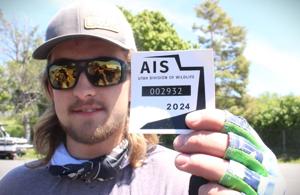
LOGAN- Boaters on Hyrum reservoir, Bear Lake and Willard Bay reservoir should be prepared to show they follow the state’s quagga mussel mandate.
Utah Division of Wildlife Resources conservation officers will be patrolling over the Memorial Day weekend to talk to boaters and help prevent the spread of aquatic invasive species.
As of July 1, 2023, the Utah Division of Wildlife Resources mandated a Mussel-aware Boater Course, an online education program for both Utah residents and nonresidents. The course provides important information about aquatic invasive species for anyone who plans to recreate in Utah waters.
If someone has previously taken this course, be aware that many questions in this year’s version have been updated with new information. The course takes approximately 20 minutes to complete and requires a score of 100 percent.
After passing the course, DWR sends a uniquely numbered and personalized annual Mussel-aware Boater Education Course certificate that you can print for proof of completion, or download it to your DWR Hunting and Fishing mobile app. It is valid for this calendar year.
DWR conservation officers will be patrolling the water this weekend both Saturday and Sunday at various waterbodies across Utah. They will be checking to make sure boaters are following the various aquatic invasive species laws.
“We want to let the public know in advance that these patrols are happening, so they can make sure they are educated about the current aquatic invasive species laws and are in compliance with those laws,” DWR Aquatic Invasive Species Operations Lt. Bruce Johnson said. “Our goal is to educate the public and to prevent wildlife violations from occurring in the first place. If quagga mussels spread from Lake Powell to other Utah waterbodies, it would significantly impact water delivery systems in that area and also impact the fisheries at the affected waterbodies.”
To address fee-collection issues, the new law requires boat owners to pay their boat registration fee through the Utah Division of Motor Vehicles and then to separately pay the aquatic invasive species fee online, this means there are two separate proof-of-registration stickers.
Here is a reminder of some of the current aquatic invasive species’ laws:
- · Anyone who launches a boat or any other watercraft in Utah — whether they are a resident or nonresident — is required to take an annual mussel-aware boater course. This includes individuals with paddle boards, kayaks and other non-motorized watercraft. The annual mussel-aware boater course must be completed before the aquatic invasive species program vessel enrollment fee can be paid, and then a current-year boat decal will be mailed to you. To reiterate: Everyone using any type of watercraft must take the annual mussel-aware boater course, but only those with a motorized boat need to pay the annual aquatic invasive species fee.
- · Anyone who wants to launch a motorized boat in Utah must also pay the annual aquatic invasive species program vessel enrollment fee. To reiterate, this is not a new fee or an additional fee for boaters — it just separates the payment into two different payments. The aquatic invasive species fee is $20 per watercraft for residents and $25 per watercraft for nonresidents. If a boater has paid the aquatic invasive species program vessel enrollment fee but has not received the decal yet, they can simply show proof of payment on their phone or with a printed receipt to be in compliance.
- · All watercraft leaving Lake Powell — currently the only Utah waterbody with confirmed quagga mussels — are required to have an exit inspection during the inspection station’s hours of operation. Inspections are not the same as decontaminations. After a watercraft is inspected, it must still be professionally decontaminated before that watercraft can launch at a different waterbody. If a decontamination can’t be performed, the watercraft must follow the recommended cleaning and draining guidelines, and wait the required dry time before launching again.
- · When leaving any waterbody and when transporting watercraft, all drain plugs must be removed. Boaters should also remove any sea strainers while transporting their watercraft.
Utah has 40 inspection stations located around Utah, with some located at boat launch ramps and others along highways.

